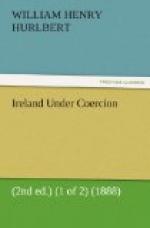It did not concern the Propaganda that these propositions ran on all-fours with the policy of the Irish Land League established by Mr. Davitt, and accepted by Mr. Parnell. What concerned the Propaganda in the propositions of Dr. M’Glynn at New York in 1882 was precisely what concerns the Propaganda in the programme of Mr. Davitt as mismanaged by Mr. Dillon in Ireland in 1888—the incompatibility of these propositions, and of that programme, with the teachings of the Church.
Upon receiving the instructions of the Propaganda in August 1882, Cardinal M’Closkey sent for Dr. M’Glynn, and set the matter plainly before him. Dr. M’Glynn professed regret for his errors, promised to abstain in future from political meetings, and begged the Cardinal to inform the authorities at Home of his intention to walk more circumspectly. The submission of Dr. M’Glynn was approved at Rome, but it was gently intimated to him that it needed to be crowned by public reparation for the scandal he had caused. He disregarded this pastoral hint, and when the Archbishop Coadjutor of New York, Dr. Corrigan, went to Rome in 1883 to represent the Cardinal, who was unequal to the journey, he found the Propaganda by no means satisfied with the attitude of Dr. M’Glynn. Two years after this, in October 1885, Cardinal M’Closkey died, and Dr. Corrigan succeeded him as Archbishop of New York.
Between the first admonition given to the sacerdotal ally of Mr. George in 1882 and this event much had come to pass in Ireland. The Land League suppressed by Mr. Forster had been suffered to reappear as the National League by Earl Spencer and Mr. Trevelyan. Sir William Harcourt’s stringent and sweeping “Coercion Act” of July 11th, 1882, passed under the stress of the murders in the Phoenix Park, expiring by its own terms in July 1885, Mr. Gladstone found himself forced either to alienate a number of his Radical supporters by proposing a renewal of that Act, or to invite a catastrophe in Ireland by attempting to rule that country under “the ordinary law.”
He elected to escape from the dilemma by inviting a defeat in Parliament on a secondary question of the Budget. He went out of power on the 9th of June 1885, leaving Lord Salisbury to send the Earl of Carnarvon as Viceroy to Ireland, and the Irish party in Parliament to darken the air on both sides of the Atlantic with portentous intimations of a mysterious compact, under which they were to secure Home Rule for Ireland by establishing the Conservatives in their places at the general election in November.[7]
What came of all this I may briefly rehearse. Going out to America in November 1885, and returning to England in January 1886, I remained in London long enough to assure myself, and to publish in America my conviction of the utter hopelessness of Mr. Gladstone’s “Home Rule” measure, the success of which would have made his government the ally and the instrument of Mr. Parnell in carrying out the plans of Mr. Davitt, Mr. Henry George, and the active Irish organisations of the United States. All this is matter of history.




